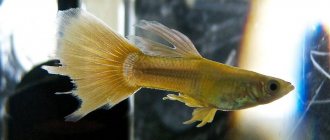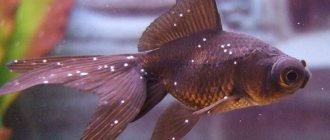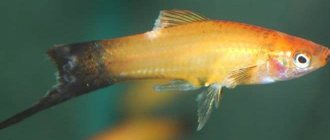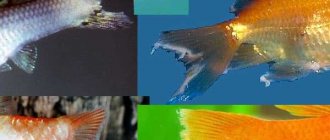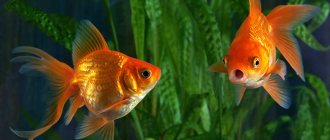Home/FISH DISEASES/Fin rot: treatment, how to save aquarium fish
Fish disease fin rot (Pseudomonas) is an infectious pathology of a bacterial nature. The disease is caused by the bacterium Aeromonas or Vibrio Pseudomonas. The problem is well known to aquarists and occupies a leading position among all diseases of aquarium fish. If left untreated, the rot progresses and leads to the death of the fish. Young animals cannot always be saved, even with timely assistance, while in adults the survival rate of the disease is high. The sooner the owner noticed the problem, the easier it will be to fix it.
Which fish get sick more often?
Fin rot in fish occurs more often in certain species with fairly large fins that form folds. The following are predisposed to the disease:
- angelfish,
- cockerel;
- neon;
- guppy;
- mollies;
- barb;
- veiltail
The disease also affects short-finned fish, but less frequently. After recovery, fish prone to illness cannot always restore the original appearance of their fins. More often they experience noticeable shortening and preservation of an uneven edge. Also, the rays of the fins after regrowth do not retain an even shape and have knots and breaks. If the rot of the fins has progressed and ulcers have formed on the body of the aquarium inhabitant, treatment is useless.
Symptoms
If a disease occurs in at least one individual, it is necessary to treat all the inhabitants who shared the same body of water with it. To prevent illness, check your aquatic pets regularly. The first signs are a bluish-white clouding of the edges of the fins, which has not previously been observed. As the disease progresses, the tips of the fins die off, then they become completely shortened or split into rays. Aquarists describe this disease as follows: “The fish looks like it has “decayed” edges of its fins and it looks like its tail has been “eaten out” by someone” or “The fish’s tail fin seems to have frayed into strings and has broken off in some places.”
The presence of a combination of the following symptoms indicates an advanced stage of the disease:
- red spots at the bases of the fins;
- ruffling of scales and their loss;
- possible bulging eyes, enlarged abdomen;
- the fins are destroyed, and erosions form in their place (the risk of infection entering the blood is high, then the fish dies).
In acute cases of the disease, fish die en masse; in chronic cases, the fish can be saved if adequate and timely treatment is provided. The disease should not be confused with ordinary fin injury, mycobacteriosis or ichthyophonosis. You can read about what other fish diseases exist and what their symptoms are here.
Causes of rot
Individually pathogenic bacteria are constantly present in aquarium water, which is considered normal. They are not dangerous for aquarium fish, whose immunity resists them. The situation changes at the moment when, due to unfavorable conditions, a sharp drop in the natural protective forces of the fish occurs, or bacteria begin to actively multiply. If the number of pathogens increases rapidly and significantly, the fish cannot protect themselves from them. Fin rot is caused by the following factors:
- severe stress in fish;
- rotting plants in a pond;
- low water temperature;
- high water temperature;
- insufficient cleanliness in the aquarium;
- incorrect selection of fish in the vicinity - if some of the inhabitants of the aquarium are aggressive and damage the fins of the others, then bacteria can easily enter their body through the wounds;
- improper feeding of pets - a lack of necessary substances in the body leads to a weakening of the fish and a decline in its immunity.
When buying fish, they are examined to identify pathologies, including destruction of fins. If there are defects, you cannot buy a fish, because even if it is not sick yet, pathological pathogens will penetrate through the wounds on the fins after stress due to the move and fin rot will develop, the treatment of which is not always successful.
Initial stage of the disease
Treatment of fin rot in a community aquarium should begin immediately; at an early stage, the infection is easy to neutralize. Carefully remove the infected fish to a separate tank of purified water. Do the same action with other inhabitants. The aquarium is emptied as it needs a thorough cleaning. At the initial stage, a simple change in the living conditions of the fish and the destruction of the infection with medications helps. The water is heated to the highest possible temperature, sea salt is added, if acceptable for this species, and potassium permanganate baths are made. In 90% of cases, these actions help, and the colorful underwater inhabitants live for a very long time in their house.
Interesting! A female eel has set an unreal record among aquarium fish. She lived to be 88 years old! She was caught in 1860 in the Sargasso Sea, and she died in 1948 in one of the museums in Helsinki.
Symptoms
The symptoms of the disease are characteristic and allow you to accurately diagnose it. In aquarium fish with pathology the following occurs:
- red spots on the fins - this is what blood vessels look like that are clogged, which stops blood circulation in the fin and causes it to decompose;
- cloudiness of fins;
- white-blue border on fins;
- destruction of the caudal fin, in which its edge becomes frayed;
- destruction of pectoral fins;
- shortening of fin rays;
- the formation of ulcers on the body in the place where the fins were previously - the pathology affects the muscular and circulatory systems, and treatment in such a situation is already useless;
- blurred eyes.
Fin rot can be successfully treated only when treatment is started from the first symptoms. When the fins are completely destroyed and the rotting has spread to the body, the most humane thing to do is to kill the sick fish, since it is no longer possible to help it.
The disease is transmitted from a sick individual to a healthy one, and therefore, having acquired new fish, you need to keep them in quarantine for 7-10 days. Only purchased pets should not be kept in a community aquarium immediately.
Where does fin rot come from?
The causative agent is the bacterium Pseudomonas fluorescens.
It lives in natural reservoirs, and enters the home tank through food, soil, decor, or from new fish from the store that have not been quarantined. Advice!
After purchasing, do not immediately place the fish in the aquarium. Leave them in an old tank of store-bought water for a couple of days. Gradually add water from your vessel to it. The fish need to get used to the new environment. In addition, you will make sure that the new underwater resident is non-infectious. The infection destroys the fish's fins, they become torn, worn out, and injured. Inexperienced aquarists think that this is mechanical damage, so they do nothing, and the pets die. The danger is that there is little time for treatment, the disease develops quickly. The main causes of infection include:
- dirty water, no filter;
- untimely or poor cleaning of the aquarium;
- failure to comply with the required temperature conditions;
- increased acidity level;
- stress factors (therefore you need to take care of the comfortable existence of the fish, choose the right decor, additional equipment).
Salt
With timely treatment, fin rot can be eliminated with table salt. The fish are given a bath with it, for which 3 small (level) teaspoons are dissolved in 5 liters of settled water. The sick individual is kept in the bath for 15 minutes. Salt baths are repeated every other day until complete recovery. If therapy is carried out on Corydoras, Teracatum or Callichthid catfishes, the solution is made in the proportion of 2 g of salt/1 liter. The rest of the procedure is the same.
Treatment
Treatment of fin rot individually and in a general aquarium must be started immediately after the disease is detected. Its effectiveness depends on the degree of damage to individuals. It is easiest to cope with the disease at the early stage of development of fin rot. In this case, improvements in living conditions are sufficient. Alternative treatments:
- Aquarium treatment;
- Traditional methods;
- Special preparations.
Important! Throughout the treatment, it is necessary to monitor the animal’s well-being. If decay continues to progress, it is recommended to change the treatment regimen.
The recovery period has no standard duration, since the animal’s recovery directly depends on factors such as:
- Age;
- Presence of concomitant diseases;
- Immunity indicators;
- Environmental conditions.
The rules for using different treatment methods are also different.
Potassium permanganate
Potassium permanganate or “potassium permanganate” is used in treatment as a substance for medicinal baths. The concentration of the solution should be from 1 to 1.5 g per cubic meter of water. It is recommended to place the fish in the bath 2 times a day for 10 minutes.
Salt
Just like with potassium permanganate, table salt is used to make medicinal baths. The recommended dosage is 7 grams of salt per 6 liters of water. Treatment must be carried out twice a day for 15 minutes.
Hydrogen peroxide
You can treat fin rot infection in a community aquarium using hydrogen peroxide. It destroys living rot bacteria. During processing, an oxidation process occurs, so after each use it is necessary to change some of the water. It is recommended to use a 3% peroxide solution. The course of treatment averages from 1 to 2 weeks.
Note! Before adding the substance to the aquarium, it must first be dissolved in water using a separate container. This avoids burns on the animal.
Drugs
In addition to the folk methods listed above, you can purchase specialized medications that destroy fin rot bacteria. You can find them in regular pharmacies or pet stores. Recommended drugs include:
Levomycetin
A common antibacterial agent found in every pharmacy. Non-toxic to fish and aimed at treating symptoms. The course of treatment is not limited. Once every three days, you need to dissolve 1 tablet in water and add it to the aquarium, maintaining a ratio of 1:20.
Streptocide
Available in powder or tablet form. When eliminating bacteria, it is used both for making baths for infected fish and for adding to the aquarium. In the second case, it is important to dissolve the drug in water at a temperature of about 27 degrees. The recommended concentration for baths is 1.5 g per 10 liters of water. Animals should be kept in them for no more than half an hour a day.
Furacilin
An inexpensive and accessible product that does not have a negative effect on water and fish. The recommended course of treatment is up to two weeks. Apply according to the schedule 2 times a day with an interval of one day. For an aquarium of 30 liters, 1 tablet of 0.02 g is needed.
Biseptol-480
Treatment consists of keeping the infected fish in a solution aquarium for a week. It must be replaced daily. Preparation of the mixture consists of dissolving 1/8 of the tablet in 5 liters of liquid.
Important! During the course, it is necessary to provide the animals with a sufficient level of aeration in the solution.
Bicillin-5
The release form of the drug is powder, sold in bottles. The treatment regimen is the preparation of a solution into which infected individuals are placed daily for half an hour. When properly prepared, the powder is enough for 1 course of treatment, 6 days long. For 10 liters of water, 1/10 of a bottle is needed.
Antipar
A specialized and powerful remedy against fin rot, which can be purchased at pet stores. The drug is added to the aquarium with an already prepared solution, maintaining a ratio of 1 ml/50 l. Before this, you need to replace a third of the volume of water with fresher water, remove the aquarium from sunlight, eliminate feeding, turn off aeration and filtration. The recommended course is from 5 to 7 days.
In case of severe infection, a medicinal bath is required in a concentration of 1 ml/10 l. It is necessary to keep animals in it for about 3 hours. You can repeat it only after a day.
Potassium permangantsovka
Manganese (potassium permanganate) is used at the rate of 1 g/20 l of water. First, the substance is dissolved in a glass of water, and then half the portion is poured into a bath container. The sick pet is placed in the bath for 5 minutes and then the remaining volume of the solution is added. The fish are kept in the bath for another 5 minutes and returned back to the general aquarium. The procedure is carried out in the morning and evening before the process of fin restoration begins.
Aquarium treatment
If an infection is detected, a number of recommendations must be followed:
- Remove all decor, soil and equipment from the aquarium.
- Rinse items with hot water and dry.
- Wash the tank itself with warm water without detergents and treat it with a chloramine solution.
- Completely change the water.
Important! After treatment and treatment of the aquarium, it is recommended to consult a veterinarian for advice on releasing animals. This will reduce the chance of relapse.
Prevention
Prevention of the disease is of great importance. Keeping your fish healthy is much easier than treating them. To prevent the development of rot in aquarium fish, you need:
- weekly water change by 20% with bottom cleaning;
- use of high-quality complete feed;
- giving bloodworms once a week to herbivorous fish and 2 times a week to omnivores;
- quarantine of newly purchased aquarium fish for 10 days;
- Quarantine jigging of fish of questionable health.
When therapy is started on time, most pets recover and fairly well restore fins affected by rot.
Don't forget to share this article with your friends ッ
AdminAuthor of the article
Did you like the article?
Share with your friends:
Exophthalmia
If your bettas have a bulging or swollen eye, the water should be tested for nitrite, nitrate and ammonia. Inflated values require a partial change of fluid at the same temperature, so as not to cause stress and even greater protrusion.
Bug eyes in a cockerel are not a disease, but a symptom.
The cause of the disease is also considered to be an inappropriate amount of pH in the water and hardness; other factors are:
Mycobacteriosis
Therapy for “fish tuberculosis” is carried out with antibiotics, it is quite long, and after that it is necessary to take vitamins. The eyes of a cured cockerel do not return to place, it becomes unsuitable for procreation, medications only prolong life.
Aeromonosis, pseudomonosis, viral infection
All these diseases have similar symptoms: the appearance of red spots, bulging eyes, ruffled scales, ascites. Treatment is carried out with the drug Antibak-250, its effectiveness is high at the stage of bulging eyes, further therapy is practically pointless.
Protozoal or helminthic infestations
The choice of medication depends on the type of worm. Helminthiasis is eliminated by Azinox, Biltricide, Praziquantel. If necessary, medications for betta fish can be replaced with medications from a regular or veterinary pharmacy.
Mycobacteriosis
Tuberculosis is often transmitted by river fish and live food. Fish that have contracted tuberculosis behave passively, they have a inhibited reaction, they often lie on the bottom or hide in the corners of the reservoir. The appearance of the fish also begins to change: the abdomen sags, scales fall out, the abdomen enlarges, ulcers appear, and the color fades. Sometimes bulging eyes are observed, the eyes become cloudy, the fish swim as if they are jumping and refuse food.
After the diagnosis has been established, it is necessary to treat the fish in the hatchery by adding antibiotics to the water and food: Ichthyovit, Antibak Pro, Kanamycin, Rifampicin, immunomodulator Vetom. The water temperature is raised to the maximum, the aquarium is disinfected.
Oodiniosis
The disease in males is provoked by poor quality care, hypothermia, and infection from other individuals. The main manifestation of oodinosis is the presence of a yellow coating on the body; other signs include:
- breaking and ruffled scales;
- paleness;
- rapid breathing;
- drooping and stuck together fins.
Oodinosis or corduroy disease. Over time, plaque covers the entire body of the fish.
Therapy for “corduroy disease” can be carried out: Antipar, Ichthyof, Formamed, Seraoodinopur water condenser. The drugs are used for all betta fish, even if one is sick, otherwise they will infect each other. The aquarium and accessories are disinfected. During the quarantine period, the water temperature is increased.
Protozoa
Most often, the body of the angelfish is affected by protozoa, which in turn can cause a number of diseases. The following symptoms will make it much easier to recognize the presence of this type of infection:
- The lateral line is deformed.
- Waste products change their color to white.
- The feces are thin, resembling white thin threads, and they are quite long.
If the condition is satisfactory, it is quite possible to save the animal; to do this, it is enough to select special preparations at the pet store. In severe cases, death is inevitable.
Attention! All fish that were with an infected individual must be treated for preventive purposes.
Plistophorosis
The causative agent is an amoeba-like parasite that settles in the muscle tissue of fish. The fungus reproduces by spores, so the disease spreads quickly. The fish stop feeding, they begin to become exhausted, their skin color turns pale, and whitish or gray spots can be seen under the skin. Parasites destroy muscle tissue, so fish often experience poor coordination and fins that stick together. Infected individuals die, since there are no effective cures for plystophorosis.
The aquarium must be disinfected with chloramine or potassium permanganate, the soil must be boiled or heated over a fire, plants must be thrown away, and diseased fish must be destroyed.
Dropsy
Ascites is caused by metabolic disorders, improper feeding, Ichthyosporidium fungus, bacterial and viral infection.
With dropsy, the body swells, the scales become ruffled, and bruises become visible underneath.
In addition to a bloated abdomen, loss of appetite and lethargy, external signs of dropsy in males include:
- ruffled scales;
- redness on the belly or fins;
- ulcerative lesions;
- bruising;
- long white feces;
- rapid breathing;
- bulging eyes and lightening of the gills;
- fluid accumulated in the organs, leading to discoloration.
Basically, dropsy leads to the death of betta fish. You can try to cure the initial stages of the disease using oral medications: Sera bakto tabs, Sera baktopur direct, Sera cyprinopur, Furan-2, Sera ectopur. The water temperature should be 26-28 degrees.
If therapy is unsuccessful, the cockerels are killed, the aquarium and its contents are disinfected.
